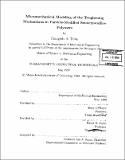Micromechanical modeling of the toughening mechanisms in particle-modified semicrystalline polymers
Author(s)
Tzika, Panagiota A., 1973-
DownloadFull printable version (7.521Mb)
Advisor
Mary C. Boyce and David M. Parks.
Terms of use
Metadata
Show full item recordAbstract
It is now well appreciated that a number of sernicrystalline polymers can be effectively toughened by the addition of a well-dispersed secondary phase. In particular, when the average interparticle matrix ligament thickness, A, of the blend is reduced below a critical length parameter, Ac, dramatic jumps in toughness levels are observed. This critical parameter is a specific material characteristic of the base polymer and can be achieved by various combinations of filler particle volume fraction and particle size. Recently, the significant improvements in toughness achieved when A ::; Ac were attributed to a morphological transition taking place when interface-induced crystallization of characteristic thickness, Ac/2, successfully percolates through the primary phase. These transcrystallized layers are highly anisotropic in their mechanical response and, as a result) change the preferred modes of plastic deformation in the material, enabling the large plastic strains) which provide the high toughness. This study aims to elucidate the micromechanics and micromechanisms responsible for the high toughness exhibited by these morphologically altered heterogeneous material systems via a series of micromechanical models. The case of polyamide-6 modified with spherical elastomeric particles was modeled. The finite element method was employed to conduct a parametric study on the deformation of these systems. It was found that the mechanical response and local modes of plastic deformation of rubber-modified polyamide-6 depend strongly on the assumed particle distribution) the morphology of the primary phase, the volume fraction of filler particles and the level of applied stress triaxiality. In particular it is shown, that in the case where transcrystallized material spans the interparticle ligaments, the unique morphology of the matrix impedes dilatational expansion of the material, while promoting ...
Description
Thesis (S.M.)--Massachusetts Institute of Technology, Dept. of Mechanical Engineering, 1999. Includes bibliographical references (p. 92-95).
Date issued
1999Department
Massachusetts Institute of Technology. Department of Mechanical EngineeringPublisher
Massachusetts Institute of Technology
Keywords
Mechanical Engineering